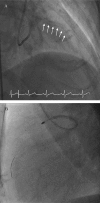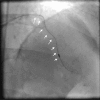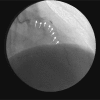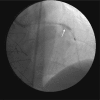Mechanism and management of burr entrapment: A nightmare of interventional cardiologists
- PMID: 24133509
- PMCID: PMC3796695
- DOI: 10.3969/j.issn.1671-5411.2013.03.013
Mechanism and management of burr entrapment: A nightmare of interventional cardiologists
Abstract
Entrapment of the burr within calcified lesion is an uncommon, but serious complication during rotational atherectomy and usually needs surgical retrieval. We report a case series of this complication and also review the possible mechanisms, such as kokesi phenomenon or insufficient pecking motion with decreased rotational speed. We also review the potential techniques ever proposed to rescue this complication percutaneously, including simple manual traction, balloon dilation to release the trap, snaring the burr as distal as possible for forceful local traction and wedging the burr with a child catheter to facilitate retrieval. Gentle pecking motion of the burr for sufficient ablation and shortening the run less than 15 s may avoid such complications. Interventional cardiologists using the rotablator should be familiar with the tips and tricks to avoid and rescue this complication.
Keywords: Complication; Percutaneous coronary intervention; Rotational atherectomy.
Figures





References
-
- Moussa I, Di Mario C, Moses J, et al. et al. Coronary stenting after rotational atherectomy in calcified and complex lesions. Angiographic and clinical follow-up results. Circulation. 1997;96:128–136. - PubMed
-
- Safian RD, Feldman T, Muller DW, et al. et al. Coronary angioplasty and Rotablator atherectomy trial (CARAT): immediate and late results of a prospective multicenter randomized trial. Catheter Cardiovasc Interv. 2001;53:213–220. - PubMed
-
- Khattab AA, Otto A, Hochadel M, et al. et al. Drug-eluting stents versus bare metal stents following rotational atherectomy for heavily calcified coronary lesions: late angiographic and clinical follow-up results. J Interv Cardiol. 2007;20:100–106. - PubMed
-
- Sonoda S, Morino Y, Ako J, et al. et al. Impact of final stent dimensions on long-term results following sirolimus-eluting stent implantation: serial intravascular ultrasound analysis from the sirius trial. J Am Coll Cardiol. 2004;43:1959–1963. - PubMed
-
- Fujii K, Carlier SG, Mintz GS, et al. et al. Stent underexpansion and residual reference segment stenosis are related to stent thrombosis after sirolimus-eluting stent implantation: an intravascular ultrasound study. J Am Coll Cardiol. 2005;45:995–998. - PubMed
LinkOut - more resources
Full Text Sources
Other Literature Sources
